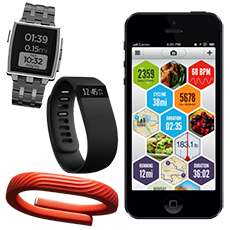Blog Articles
Wednesday, December 10th, 2014
 Health wearables and apps have been gaining public interest for years now, and this is a trend that is only expected to grow.
Health wearables and apps have been gaining public interest for years now, and this is a trend that is only expected to grow.
By the end of this year, more than 18 million wearables will be in use. By 2018, that number is predicted to triple.[1] At this time, a quarter of American adults report using some form of fitness tracker or smartphone app to keep an eye on their health, weight or exercise.[2]
With these devices, we now have unprecedented access to information about the food we’re eating and drinks we’re consuming. We can measure the number steps we take and calories we burn. Tracking how far we run and how fast our heart beats are within our grasp, as is assessing how soundly we sleep and how stressed we feel.
Over time, we can look at trends revealed by our personal data to discover what is normal for us as individuals, identify bad habits to break or new healthy habits to form, and provide concrete metrics for our doctors when we suspect something is wrong.
That being said, all of these tools are only as powerful as the input they receive. Simply downloading an app or owning a FitBit doesn’t mean it will provide any use at all. Even if it’s just by scanning a barcode, we still need to track our food, and we still have to wear the devices for them to count our footsteps.
Until devices are able to measure without our help—via implantation or forms of remote monitoring—we as owners must be diligent about inputting data ourselves.
Fard Johnmar, Founder of Enspektos, argues that relevance is the key to increasing the public’s use of these tools.
The relevance of the data they provide is certainly tantamount. We may not be particularly concerned with the number of steps we are taking daily, for instance, if our primary interest in tracking our health is training for a 5k.
Equally important is the relevance of what these tools are able to do for us. Can they lower our insurance premiums? Not yet, but perhaps one day. In addition, how well do they complement our lives? Are we already plugged in to technology, or are we looking for more unobtrusive ways of measuring our health?[3] All of this comes down to individual choice.
It is almost certain that we will continue to see an explosion of the number of devices in the market and in households in the coming years.
We will also likely experience segmentation, as devices and apps becoming increasingly tailored to different audiences. Individuals seeking weight loss will be interested in different metrics than people training to run a marathon.
What is certain is that informaticians like those at UTHealth SBMI will devise new and ever more useful ways of analyzing and applying this wealth of personalized information so that it may improve individuals’ wellbeing, guided by the expertise of physicians and other health care practitioners.
[1] Juniper Research. Smart Health & Fitness Wearables: Device Strategies, Trends & Forecasts 2014-2019. 2014 Nov 25; accessed 2014 Dec 4 at http://www.juniperresearch.com/researchstore/devices-wearables/smart-health-fitness-wearables/device-strategies-trends-forecasts
[2] TechnologyAdvice. Wearable Technology & Preventative Healthcare: Trends in Fitness Tracking Among U.S. Adults. 2014 Aug; accessed 2014 Dec 4 at http://research.technologyadvice.com/wearable-technology-study/.
[3] Johnmar F. Are Health Wearables Evangelists Fools? HIT Consultant. 2014 Oct 8. Accessed 2014 Dec 4 at http://hitconsultant.net/2014/10/08/are-health-wearables-evangelists-fools/.